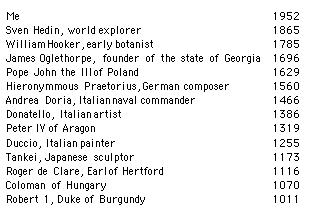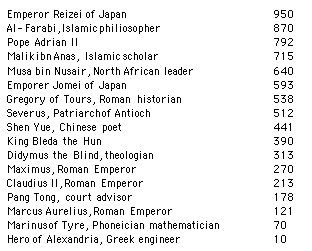13 Generations
[Translations: Japanese]
A wise society would take the long view. When accessing its environment, for instance, a smart culture might ask itself what consequences would alterations in genetic sequences of wild or domesticated organisms, or introduced species, have in one thousand years? What happens to spent nuclear fuel over 1,000 years?
But 1,000 years is too distant and remote to even contemplate, particularly for busy contemporary folk like us who have trouble making next summer’s vacation plans. Ten centuries so exceeds our own lifetime and the horizon of our imagination that we want to dismiss it as extraneous and unapproachable, and simply not worth thinking about. The Singularity concept is a direct consequence of this difficulty. Believers in the Singularity pronounce, in quasi-scientific terms, that imagining one thousand years from now is literally impossible. But even without the faith in a Singularity, when reckoned in years, a millennial seems forever.
But reckoned in human life times, it is nearer than it first looks.
For most of history a human generation, and not years, was the cultural unit of time. Traits, “blood,” sins, promises, and obligations were passed along in terms of generations. When people looked back (there was no future then) they did so in terms of generations. They could recite the generation jumps by memory. A typical generational roster like the following sequence in the Bible book of 1 Chronicles lists 13 familial generations of father to sons:
Eleazar begat Phinehas, Phinehas begat Abishua, And Abishua begat Bukki, and Bukki begat Uzzi, And Uzzi begat Zerahiah, and Zerahiah begat Meraioth, Meraioth begat Amariah, and Amariah begat Ahitub, And Ahitub begat Zadok, and Zadok begat Ahimaaz, And Ahimaaz begat Azariah, and Azariah begat Johanan, And Johanan begat Azariah.
If the average age of fatherhood was 25 years, then this span of 13 generations spans more than 300 years.
But there is another definition of generation besides father/son begatting that might be useful. We might count a full lifespan as a generation. A generation would go from birth to death, birth to death, and so on for 72 years on average. Imagine if we were trying to pass on a treasure and all that was necessary was that one person be alive – if even for a day– during the life of another to transmit it. That treasure might be an artifact – say a pocket-size library, or some knowledge, or perhaps some wisdom – which can be passed from one holder to the next in a chain. As long as a person is born before the previous holder dies the generation chain remains unbroken.
We are evolved to hold generations in our head. How many generations fit in a thousand years? I recently constructed a virtual personal generational chain by searching Wikipedia for a notable person who died shortly after I was born. A few minutes searching turned up the explorer Sven Hedin. I then found a Wikified person who was born shortly before Hedin died. And then someone born before he died, and so on. With little effort I soon arranged a chain of only 13 people that reaches back 1,000 years.

In this virtual chain, the Duke of Burgundy, who was born in 1011, could have personally passed on his formula for success to Coloman of Hungary, who could have passed it on to Roger de Clare, and so on, all the way to Sven Hedin, who could have passed it on to me before he died.
None of the notable luminaries in this chain ever met, so this unbroken circuit is purely conceptual. I was forced to use notable people who were unlikely to cross paths with each other because we have so few historical birth records for ordinary folk. The further back you go, the fewer personal records of any sort, and the more difficult it becomes to make an optimal generation chain. We occasionally find a record of someone’s death; the only people with recorded birth dates are the famous.
However unnamed people in ordinary families could easily form a relational chain with the same span, with a great grandson arriving before the great grandfather dies. We could imagine the grandfather picking up the infant, and perhaps in some indirect way transmitting the wisdom of his grandfather to this next generation.

We might further imagine a 70-year-old person standing with her arms outstretched in each direction – from the past of her birth to the future of her death – fingertips touching the previous generation and the following generation. With a chain of outstretched hands, each representing 70 years, we need only line up 13 people, fingertip to fingertip, to have them stretch their lives over 1,000 years.
If I hopscotch thirteen generations into the past, I can land in the year 1000 AD. But why stop there? I can continue for another 13 generations of born-before-the-other-is-dead generations and reach the year 10 AD, during the lifetime of Jesus.

This means that there are only 26 human touch-generations between me and Jesus of Nazereth. I could form a human bridge between me and Jesus, or Caesar, or Hero of Alexandria with only 26 people reaching out finger tip to finger tip across time. Those 26 people could fit into one room.
Calculated this way 1,000, or even 2,000 years doesn’t seem so distant. To span 1,000 years we need only 13 lifespans. We can hold a list of 13 names connecting us to the year 1000 AD in our head, and many people in the past have done so.
Going in the opposite direction we can imagine only 13 lives (and perhaps fewer if longevity increases), linking us and the year 3000 AD. Between you and the year 3000 AD stand only 13 lifetimes. In terms of lifetimes — which are steadily increasing due to medical progress — 10 centuries is just next door.
But in technological change terms, 10 centuries is a distant as another galaxy. Consider all the revolutions that have happened in the last century: automobile, the pill, digital communications, jets. Now times it by 10 or 100 more. Landing in the next millennial will be like landing on an alien planet.
But we can land on this alien plant in less than 13 human lifespans. And that we can imagine.


